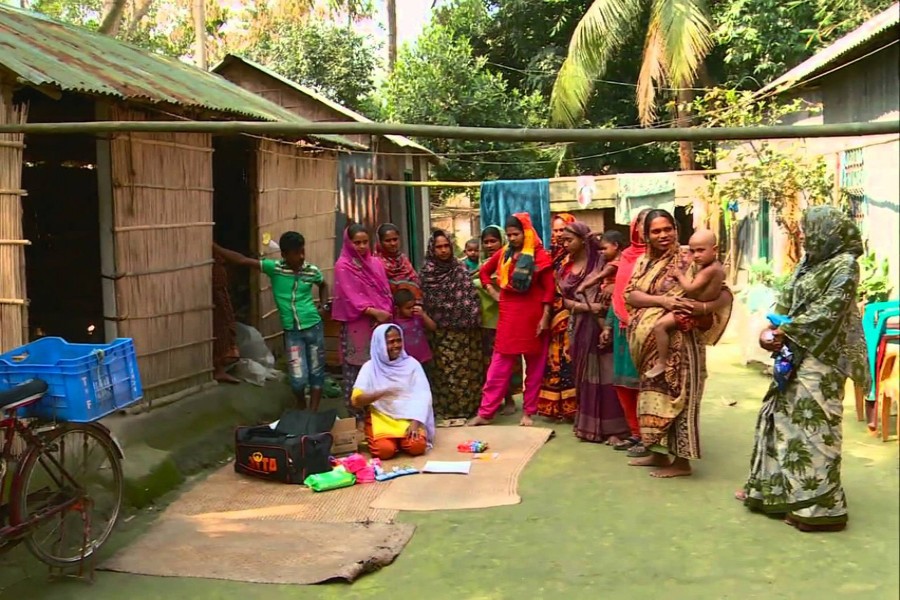There are various factors to fuel income of rural households. Land - irrespective of owned or rented - has historically been the most important asset in generating household income. Household income also depends on the number of working members within the household, access to infrastructure, credit as well as the non-land assets used in production. However, the roles of these factors have changed over time.
Over time, the contribution of irrigated land in household income has marginally increased, but that of rain-fed land has substantially decreased. The main income now comes from irrigated boro rice instead of rain-fed aman variety. The fluctuations in the income of rural households have also reduced over time in tandem with increased use of mechanised farming, replacing nature-dependent farming.
It is also noticeable that the contributions of workers in household income has increased despite a reduction in the number of agricultural workers in the household. That means, productive power or productivity of agricultural labour has gone up over time. The contribution from non-agricultural workers has almost doubled in recent times. By and large, the contribution of labour in household income now accounts for roughly half of the total household income compared to only 25 per cent few decades back. The policy implication of this change points to the need for enhancing access of workers to education, training and health as these would raise their income via increased productivity. Besides that, employment generation also requires expansion of infrastructural facilities.
Available empirics suggest that the contribution of schooling has marginally declined in changing household income. This does not, however, mean that importance of schooling has diminished as such. We, rather, reckon migration of rural workers is playing a greater role. The contribution of migrating members to household income has increased four times. In other words, the number of migrating members in educated households is increasing. Income, therefore, is also higher.
Meanwhile, agricultural and non-agricultural capital of households has increased over time and their contribution has also increased. And as argued before, remittance income increased its share as migrant members of the households increased over the years. The contribution of access to electricity is apparent from the fact that the access increased its share from about 5.0 per cent to roughly 10 per cent over time. It should also be mentioned that 4.0-5.0 per cent of household income in rural areas flows from accessing credit delivered by non-governmental organisations (NGOs).
Finally, if we search for the most dominant determinant of household income, we find that it is the labour force, which is contributing the most to household income. The second contribution comes from agricultural and non-agricultural capital - thereby putting in about one-fifth of income. Land, being the most powerful asset, accounts for about 20 per cent of the household income as against about one-third share in the past. This apparently indicates that rural livelihoods these days are increasingly dependent on non-land assets. Human capital contributes roughly 10 per cent and infrastructure another 7.0 per cent of household income. Provisions for education and electricity have a more important role to play in affecting rural income and livelihoods compared to land.
The degree of inequality in distribution of income is generally measured by the Gini coefficient. It appears from household-level surveys that the bottom 40 per cent of rural households (representing the poorest segment) lost their income share between the 1980s and recent times by approximately 20 per cent. But, during the same period of time, the top 10 per cent (representing the richest segment) increased their share. In this case, the income inequality - as reflected by the Gini-concentration ratio - rose tentatively from 0.434 to 0.447. However, the bottom 40 per cent regained some of their lost share in recent period while the top 10 per cent lost some. This resulted in the fall of the Gini index. The same pattern prevailed in the case of total income. The question that may be asked is: why is there a downturn in income disparity in most recent periods?
One may easily surmise that the access to assets, especially non-land assets, was mostly captured by the richest segment of the rural society in earlier times. For example, this group first seized upon the advantages of modern technology in paddy production. But in later periods, poor farms have also picked up the package. Besides, schemes like free primary education and stipends for girls in secondary level have also increased opportunities for the poor. And finally, the spread of tenancy market and tightness in labour market also appear to have gone to favour the poor.
In rural areas, both equalising and non-equalising factors persist. First, agriculture in general and paddy farming in particular, is an equalising factor. It may be due to the fact that, of late, the rich have almost left farming and the poor replaced them. But non-rice crop and non-crop agriculture, to some extent, increase inequality. These activities require some amount of capital in which the poor have relatively less access. Besides, high-value crops are now grown on commercial basis by large farms, instead of the subsistence and home-based production of earlier periods. This has also created income disparity. Third, the largest factor of inequality is the income from non-agricultural sources.
The Gini coefficient is very large and the concentration is prominent in the case of business and trade and also in services and remittances. Business, services or migration need a lot of money and education. Only the rural rich could so far access these opportunities and, thus, increase their income. On the other hand, the level of income from these pockets is very low for the poor in absence of access. It is possibly not surprising that, as such, the Gini index has depicted an upward trend.
To rein in income disparity, education, credit and training opportunities must be taken to the doorsteps of the poor.
Abdul Bayes is a former Professor of Economics at Jahangirnagar University.


